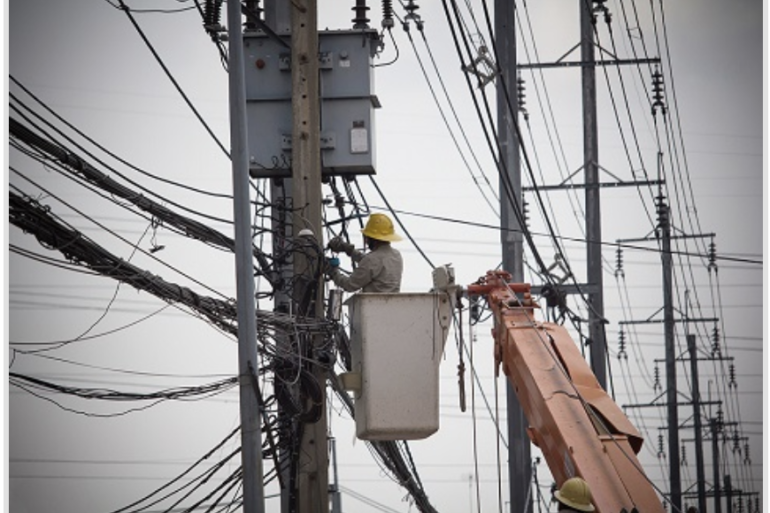
The Same Communities Reeling from COVID-19 are Hit Hardest by Utility Disconnects and Power Outages – Resilient Power Can Help
 Authors: Marriele Mango, Clean Energy Group, and Mayra Cruz, Catalyst Miami | Projects: Resilient Power Project, Energy Storage and Health
Authors: Marriele Mango, Clean Energy Group, and Mayra Cruz, Catalyst Miami | Projects: Resilient Power Project, Energy Storage and Health
The impact power outages have on public health can be severe. Emergency management and public health leaders rely on decades of research and case studies to learn how to better prepare for natural disasters and their consequences, including widespread power outages. This year, those responsible for maintaining public health and safety face a new and unprecedented challenge: how to protect communities when a power outage coincides with COVID-19.
In August, over three million people were left without electricity by the time Hurricane Isaias dissipated. Medically vulnerable individuals, such as seniors, considered their options as their air conditioning and fans stopped working (one senior housing facility was without power for over 30 hours). Those with electricity-dependent home medical equipment, such as oxygen concentrators, were left searching for places to charge their devices. People risked exposure when they stayed with friends or relatives that still had power.
Re-Emergence of Utility Disconnect Programs
It’s not only severe weather threatening energy security. As federal and state mandated COVID-19 protections lapse, utilities will once again begin to disconnect electricity to customers behind on their bills, many of whom now depend on electricity to homeschool their children and/or work remotely due to COVID-19 restrictions. Of the 32 states that restricted utilities from conducting disconnections during the pandemic, ten have already ended their bans. Twelve more are scheduled to allow for disconnections to resume in the coming months. North Carolina and Texas, states still reeling from recent hurricanes, are set to resume disconnects in the coming weeks.
The communities at highest risk of utility disconnects are the same communities being hit hardest by COVID-19: Black, Indigenous, and People of Color (BIPOC), medically vulnerable populations, and low-income communities. The Center for Disease Control and Prevention reported that Black and Hispanic populations are nearly three times more likely to contract COVID-19 and almost 5 times more likely to be hospitalized.
Low-income and BIPOC communities are also more likely to be environmental justice communities and therefore must contend with disproportionate health impacts of COVID-19 and climate change, such as extreme heat, simultaneously. Florida, for instance, is set to resume disconnects October 1. The Florida Public Service Commission estimates approximately 600,000 customers are behind on their utility bills. As average temperatures in Florida – and throughout the Southeast region – continue to rise, disconnections coinciding with both COVID-19 and days of extreme heat could be potentially deadly.
And it’s not only health disparities—almost half of the Hispanic population has faced an economic hardship (took a pay cut or lost their job) due to COVID-19. In low-income communities, 18 percent of Hispanic and 16 percent of Black households were unable to pay an energy bill between April and May of this year, compared to under 9 percent of white households. A shocking 23 percent of low-income households with a family member dependent on electricity for a medical device were unable to pay their electric bill.
Opportunities for Resilient Power
While there is no single solution to protecting vulnerable populations through an emergency, and the situation is increasingly complicated as the COVID-19 pandemic continues, there’s an opportunity to embrace innovative solutions to build community-based solutions. It’s time to re-evaluate business-as-usual solutions and consider new, innovative technologies that can address community resilience more holistically.
Working in tandem with weatherization and energy efficiency programs, solar and battery storage systems (solar+storage) can reduce utility bills, improve emergency preparedness, and transform the energy landscape of the most vulnerable communities. Solar+storage systems are both community-based emergency power resources and economic assets; providing reliable backup power in the event of an outage, lowering energy burdens by reducing utility bills, and generating revenue through grid services during regular operations.
As a zero emissions power source, solar+storage is especially beneficial for environmental justice communities, where pollutants from fossil-fuel powered generators can contribute to already poor air quality. Solar+storage can also reduce utility burdens, the percent of income spent on utility bills, and provide an opportunity for wealth creation in low-income communities by participating in grid services programs such as demand response.
In the event of an outage, solar+storage can improve health outcomes by providing reliable power to critical loads. In individual residences, solar+storage can support some types of electricity-dependent home medical equipment through an outage or provide enough backup power to safely wait until emergency assistance can arrive. Residential systems could also help to reduce the risk of exposure during a pandemic by allowing high-risk residents to shelter-in-place.
At critical community facilities, such as medical clinics and schools, solar+storage can provide back-up power for residents to access WIFI, lighting, refrigeration for perishables and temperature-sensitive medications, and outlets to charge medical equipment and cell phones. By strategically installing resilient power systems throughout a community, influxes of people to a single critical community facility (or medical institution) could be avoided, reducing the likelihood that large numbers of people will need to gather in one place and improving the ability of the staff to maintain pandemic safety protocols.
Utilities should be making every effort possible to avoid disconnects and improve the quality of life for their most vulnerable customers. Bill payment assistance programs and medical baseline registries, a program that can help electricity-dependent customers avoid a disconnect, need to be prioritized, improved upon, and expanded. Additionally, utilities should provide subsidized battery storage programs to their most vulnerable customers, similar to the state of California’s Self-Generation Incentive Program (SGIP).
These types of programs can ensure that backup power is affordable and available to high-risk populations, while also reducing the energy burden of low-income households and providing value to the grid—which could lower electricity costs for all utility customers.
